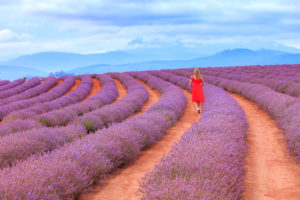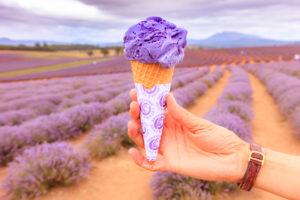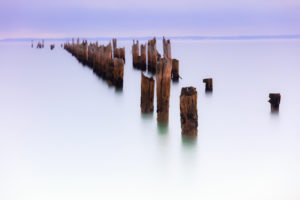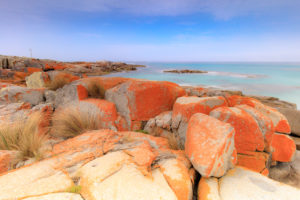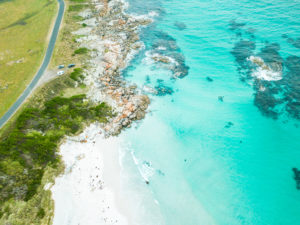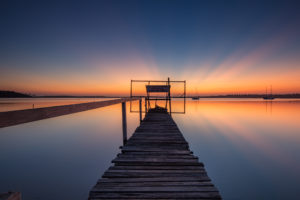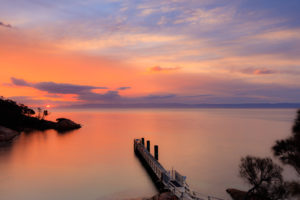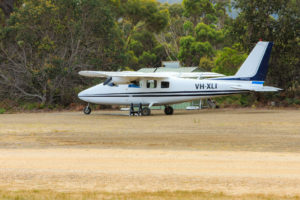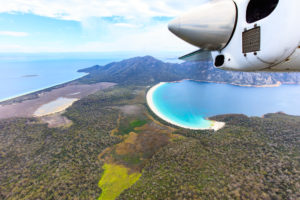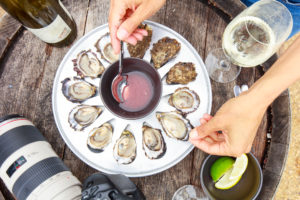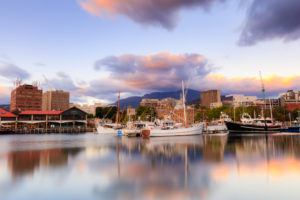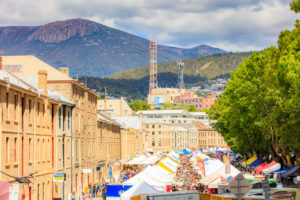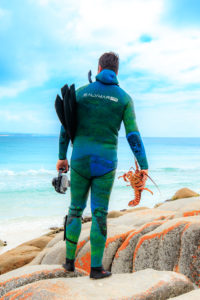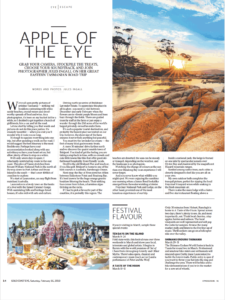We’ve all seen pretty pictures of Tasmania, striking red boulders contrasting the white sandy beaches, crystal waters, not to mention the award-winning food and wine. As a photographer, it’s been on my bucket list for a while, so I decided to get together a bunch of girlfriends and jump in a car to find the best places to explore on a road trip.
Let me start by telling you straight up, words and pictures do not do this place justice. It’s insanely beautiful. Somewhere you will visit and wonder why it has taken you so long to discover. Trying to put together an itinerary for just one week is no easy task because doing my research, there are so many worthy places to stop and visit all over Tasmania. Having now spent a week on the road, I would suggest the best itinerary is the most flexible one. Perhaps have your accommodation booked and some must do activities, but allow plenty of time to just stop on a whim.
With only one week on the road, I (reluctantly) restricted the itinerary to only the East Coast which allowed enough time to explore a whole range of locations and experiences, but at the same time didn’t feel too rushed.
The trip started in Launceston which is an easy flight from mainland Australia. Situated in Northern Tasmania, Launceston is a cute little town on the banks of a river with the famed Cataract Gorge. With undulating hills and heritage listed houses, it is rich with a great arts type culture and a perfect place to start our journey.
From Launceston, the drive up north took us to the famous Bridstowe Lavender Estate. To really appreciate this place in full bloom, you need to visit between December and early February when the flowers are in full vibrant purple bloom and the sound of bees buzzing through the fields creates this melodic peaceful atmosphere. There are guided tours by staff at the farm or just enjoy a wander through the 260 acres of the world’s largest privately owned lavender farm. It’s such a popular tourist destination, and probably on our trip, the busiest place we visited, however the sheer size of the farm didn’t give the feel of being too hectic. The only indication of its popularity was the car park. A must try is the lavender ice cream, makes the perfect Insta-pic with the purple against the purple blooms and tastes divine. The first of many local gastronomic treats we were treated to on our journey.
A short 30 minute drive further north and you will come across the quaint seaside town of Bridport. You kind of get the feeling in Tasmania that you are taking a step back in time, with no crowds and cute little towns like this, offering good old fashioned friendly locals and low key, unspoilt locations. There is such a lazy, relaxed feeling even though there is so much to see and do. Take a walk down to the old Bridport Pier and beach or if you like golf, Bridport is home to one of the best golf courses in Australia, Barnbougle Dunes Golf Course.
The east coast of Tasmania stretches from Mount William National Park in the North all the way down to Port Arthur and Bruny Island in the South. That’s over 400 km of coastline, all spectacular and all worth adding to your itinerary. If time is no issue, as many seem to do, hire a camper van and spend a leisurely few months meandering your way through the towns and beaches that make up this breathtaking landscape. For the rest of us, where time is a little more precious, there are a few must stops along the way.
The Bay of Fires is the 40 kilometres between Eddystone Point and Binalong Bay. It’s best known for the huge orange granite boulders littering the beach. The boulders are coloured from lichen that is a non harmful algae growing on the rocks giving them a rich orange hue. In stark contrast to the whitest of sandy beaches and crystal clear water this makes for the most beautiful beach landscapes. If I had to pick a favourite part of the coastline, it is probably this region. The beaches are deserted, the seas can be both moody or tranquil, depending on the weather and the landscape so picturesque. Watching the change of colours as the sun rises over Binalong Bay is an experience I will never forget.
One thing you notice road tripping in Tasmania is all the places that you MUST stop at along the way. Each day our itinerary was thrown away in place of stops at mussel and oyster farms, wineries, berry and dairy farms, or just cute towns that we just had to visit driving through. The dominate theme is local produce and this is transferred to every restaurant and café you visit. It’s so refreshing to see locals supporting locals in such a strong way and I definitely have a few new favourite wines and gins on my shopping list having sampled the local flavours.
Freycinet National Park and Lodge provided one of the most luxurious experiences of the trip. Staying inside the National Park at the 4 star Lodge you are greeted on one side by spectacular sunsets over Oyster bay and behind you the magnificent Hazard mountain ranges. The lodge is nestled in amongst native trees and wildlife and each cabin is cleverly designed to feel like you are in the National Park all on your own. Your own outdoor bath completed the experience where you can enjoy a glass of the local Freycinet Vineyard wines whilst soaking in a hot tub in the fresh mountain air. It’s such a unique experience. There is also the main lodge with a bistro and 5 star restaurant perched above a tranquil cove and newly renovated long jetty to watch the sunset over Coles Bay.
Relaxing at the Lodge you are a short walk from the gorgeous Honeymoon Bay, a popular engagement and wedding location or Richardsons Beach. There is the Cape Tourville Lighthouse and of course, Wineglass Bay. To really appreciate Wineglass Bay, there are several options. Firstly, and probably one of the best ways to truly appreciate the view is a scenic flight with local airline Freycinet Air. You get a panoramic perspective of the area as well as the most impressive views of the Bay. Second best option is the very popular track from the National Park up to Wineglass Bay lookout. A fairly light walk that takes about 90 minutes return trip, well worth the not too strenuous effort. Or for those who a really keen, but not for the feint hearted, is the walk to Mount Amos Lookout. This takes about 3-4 hours and is a difficult walk, but the view from the top of the Mountain will totally blow you away.
Not far from Freycinet Park is one of the most unique and authentic tourism experiences I have had and worth the trip to Tasmania just for this. With a focus on local produce, we ate plenty of seafood during our trip but none fresher than from Freycinet Marine Farm. Julia and Giles Fisher bought the farm in 2005 and what started with selling oysters out of the kitchen window has grown to a business producing over 5 million oysters a year. Visit the farm just off Coles Bay road to enjoy freshly shucked oysters, abalone and other local seafood treats takeaway or at their deck café. Better still, take a tour with the recently expanded offering of a true Oyster Farm experience. Oyster Bay Tours husband and wife Declan and Patrea will pick you up from the farm shop and take you a short drive to the actual oyster farm on Moulting Lagoon. You are kitted out in a wading suit (not the most attractive) which is basically gum boots built into a full rubber dungaree style suit to keep you dry whilst you wade out into the lagoon. In amongst the actual oyster farm, sample an oyster straight from the water, you can’t possibly get any fresher than that. Host Declan is full of information, stories and interesting oyster facts – did you know from inception to plate for an oyster is on average 2 years? On returning to dry land, learn how to shuck your own oysters and enjoy with fresh mussels, sea asparagus picked from the lagoon banks and a glass of local Freycinet wine. It’s such a rustic experience and so unique, you can’t leave Tasmania without trying it for yourself.
On our final few days, heading back to Hobart, a stop at the town of Richmond was recommended by many people and really worth the short detour. Home to the historic, heritage listed Richmond Bridge, it’s the oldest in Australia and the feature of many photos from the wider Hobart region. In Hobart, make sure you are in town on a Saturday for the Salamanca Markets. These are one of Hobart’s most visited tourist attractions and it’s easy to see why. Boasting the now familiar theme of local produce, you can buy everything from flowers and food to beautiful pictures by local photographers, artwork, jewellery and Tasmanian designed clothes. I even saw a blanket made from local alpaca wool. You are sure to pick up a souvenir of some sort and even just spend hours wandering through the historic streets lined with market stalls situated alongside the Hobart waterfront. It’s one of the biggest markets I’ve seen anywhere in the world.
If you are going to road trip Tasmania, and believe me, you really must do it at least once in your lifetime, spending a week driving around and chatting to the many locals in Tasmania, the thing that you really notice is that they are fiercely protective of the environment and passionate about protecting it. The roads are empty, nowhere is overrun by tourists which leaves a relaxed vibe whilst still being able to see and do so much in a short time. Surprisingly, for the landscapes that we saw, many did not involve a lot of walking or strenuous exercise. Most locations you could pull up your car and pretty much walk a few meters to the beaches and coastlines. Not only did we experience landscapes and produce, the wildlife was mind blowing. We witnessed dolphins in the wild, seals, echidnas, marine life in abundance and we all swear we even saw a Tassie Devil – although it was early in the morning so I can’t be 100% sure. By far the most impressive wildlife we witnessed was one morning relaxing on the beach at Binalong Bay, enjoying the sunshine when a James Bond look alike emerges from the water carrying a lobster in his hand. It was literally like something out of a movie, but it turns out he was just local boy “Danny” who regularly swims these waters and sees all sorts of local wildlife (although mostly he leaves it be)
The feeling you get visiting Tasmania is that in 100 years, the rest of the world will have ruined all the great tourist locations by over visiting, not respecting and over developing, yet Tasmania will plod along and remain in its unspoilt natural state. There are no high rise buildings outside the cities, I didn’t see a chain restaurant and there’s definitely a strong culture of local produce and simple, good food whilst still appreciating and admiring nature. Trying to put into words the raw beauty is a difficult task because everything seems so cliché. So many times, we stopped and just took time to take in the views without lifting a camera, just in awe of everything around us. Tasmania is a hidden gem often forgotten by the city mainland folk, but this just adds to its charm. Even if you only have 5 days to spare, jump on a plane, grab a hire car and go and visit Tasmania. I promise you won’t be disappointed and I will certainly be back to explore more of this gorgeous island.
Note that details of this adventure were also published in the Gold Coast Bulletin Newspaper weekend edition on Saturday 16 February 2019


